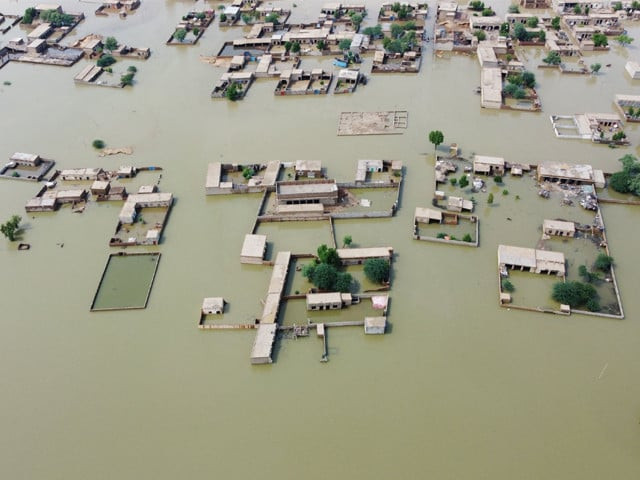Pakistan knows crisis and adversity. Yet, recent years have seen an intensity in the country’s multidimensional socio-economic and climatic challenges: climate and environmental shocks as witnessed in the 2022 floods, economic pressures with an increased debt overhang, a challenging security landscape, all happening within a context of a political transition.
Being among the 10 countries most affected by climate change (while contributing less than one per cent to greenhouse gas emissions), the impact of these pressure points will not diminish easily.
Now, imagine a Pakistan that not only survives crises but thrives despite them. A nation where, for instance, floods don't devastate livelihoods but spark innovative solutions instead. This isn't a distant dream, but a very real possibility.
The key lies in building up resilience. This may be a somewhat overused term, so what would it take? The choice to invest more intentionally in prevention and preparedness, even amidst fiscal constraints, shift policies and capabilities from reactive measures towards proactive solutions. It calls for more coordinated and integrated approaches, given the interconnected nature of the world’s contemporary crises. This takes leadership that persists to reform the public sector as well as the private sector, and to work across vertical management lines and traditional sector spaces. The cost of limited action, or worse still, inaction, is staggering. The 2022 floods caused $30 billion in damage and pushed nearly nine million people into poverty. Investing in resilience can break this cycle.
There is no easy way forward, and no policymaker, business nor civil society organiser expects one. The 2024 UNDP Human Development Report ranks Pakistan 164th out of 193 countries in the ‘low development’ category on the Human Development Index, a key metric assessing a nation's progress in improving its citizens' well-being. The country lags behind most of its South Asian peers on some critical development measures, such as gender equality, multidimensional poverty, inequality and environmental sustainability. With national forecasts projecting a modest growth outlook, and carrying a heavy debt burden, it is not a leap to say that Pakistan’s current challenges have derailed its own SDG ambitions.
With less than six years left to 2030, UNDP's Integrated SDG Insights Report 2023 for Pakistan shows that the country is on track to achieve 35 out of 169 SDG targets. With an annual SDG financing gap of US$3.72 billion, Pakistan would need to spend 16 per cent of its annual GDP to achieve all the SDGs by 2030.
To accelerate SDG progress by 2030, the country would need to consider targeted high-intensity economic reforms and accelerator pathways, some of which are already underway. Expanding the tax revenue base, and preventing tax avoidance and leakages is one path. Another is long-term sustainable and efficient debt management through innovative financing solutions, such as debt swaps, and reducing the debt service burden that is currently untenable. Pakistan spends more on debt servicing each year than it does on public health and education today. A third, is expanding a fair playing field for private sector investments to thrive. A competitively diverse base of businesses will be critical to creating new jobs, expanding tech usage and digital access, and deepening the industrial and services base for a more inclusive progress. And finally, as Pakistan is doing, to urge global attention to its climate action needs with more affordable climate finance. These pathways cannot take off and thrive without the accompanying requisite governance reforms.
Pakistan’s lift out of the ‘low-income country’ category, taking along almost 250 million people, is no doubt a difficult one, but the moment to do so is now. A newly elected government has a unique opportunity to rewrite Pakistan’s narrative and rally international partners in the process of moving from recovery to resilience. Following the 2022 floods, the international community mobilised in solidarity with Pakistan, pledging nearly $11 billion (with close to 70 per cent of that amount received) for the implementation of a national Resilient Recovery, Rehabilitation and Reconstruction Framework (4RF). This, coupled with a national economic recovery plan, provides a sound basis for furthering reforms and implementing development actions.
UNDP Pakistan and the Sustainable Development Policy Institute (SDPI), with other development actors and partners in Pakistan, have been engaged in such initiatives, which must build on a solid, hopefully irreversible, commitment to reforms as the foundation for a future-proof Pakistan. These collective efforts include:
- Ensuring that institutional capabilities, particularly at sub-national levels, are as resilient as the people they serve in the face of inevitable reoccurring crises. This includes investing in climate-resilient infrastructure, and early warning systems, and expanding the skills and livelihoods base in productive sectors.
- Economic reforms that are people-centred, including those on taxation, sustainable debt management, and opening up new private sector investments. A concrete application is investments in digital transformation of public services and local businesses, to reach more people otherwise left behind.
- Changing the development financing mix for the future. UNDP's SDG Investment and Climate Finance Facility has identified bankable projects worth $8.8 billion that look ahead and are quality-assured, as a springboard for sustainable growth. Along with JS Bank, we are testing a model of co-investing in micro and small businesses, with blended financing, for environmentally sustainable economic opportunities.
The Pakistan 2024 National Human Development Report “Doing Digital for Development”, to be launched this week, focuses on digital transformation, as one way to connect the recovery-to-resilience dots and strengthen the rebound capabilities of individuals, communities and the institutions that serve them. For a country where more than half of the population (54.3 per cent) still do not have access to the internet, digital inclusion and transformation will be key to accelerating the country’s path to sustainable development. It can also bring the other half of the population in and improve Pakistan’s overall HDI ranking.
Strong political will behind the necessary policy and governance reforms will pave the way. People’s ability to innovate, connect and strive for hope and a better future for themselves and their children will do the rest. UNDP accompanies Pakistan on this journey in the search and application of bold new pathways to progress, where everyone thrives and not just survives.



COMMENTS
Comments are moderated and generally will be posted if they are on-topic and not abusive.
For more information, please see our Comments FAQ